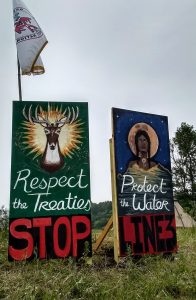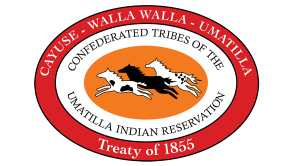Guest Column by Colleen Sanders and Jessi Pedersen
These last several months have been a marathon of challenges for everyone; as the Covid-19 pandemic still continues, record-setting “heat bubbles” have scorched the Pacific Northwest, even as the skies have been choked with smoke from local and regional wildfires burning through a historic drought. It would be foolish for us to not recognize that the specter of climate emergency is indeed a problem for our lifetimes, and not just a hypothetical problem for future generations.
Under these same smoky skies, to stand in climate solidarity with Indigenous Water Protectors, we traveled to a community on the front lines of resisting fossil fuel extraction in Northern Minnesota, home to the Dakota, Chippewa, Ojibwe, and Anishinaabe people and the world famous Manoomin, the Wild Rice. As members of the Pendleton Community Action Coalition, a Pendleton-based grassroots mutual aid volunteer organization formed in May of 2020 by Briana Spencer, we wanted to support community actions to resist fossil fuel projects and stand as treaty partners with Indigenous people, who have consistently been on the front lines of these fights. So in July, we made the long trek to northern Minnesota to be part of the Red Lake Treaty Camp in the fight against Enbridge Line 3.
The Intergovernmental Panel on Climate Change (IPCC) recently released the first installment of their 6th National Climate Assessment on August 9th 2021, and it paints a bleak “Code Red” scenario for humanity’s chances of surviving a now-likely 2 degree celsius (36 F) heating of the planet if we don’t immediately stop the widespread use of fossil fuels, and work to reverse existing emissions. To avoid this bleak future, we must actively shift away from investing in fossil fuel projects, infrastructure, and economies that rely on oil, gas, coal, bitumen, and other forms of carbon-intensive energy, as quickly as humanly possible. Which is why it is baffling that action around Enbridge’s Line 3 “replacement”/expansion has received the blessing of the Biden Administration, even as the Keystone XL pipeline was correctly halted.
Indigenous people have been sounding the alarm about the need for action on halting the climate emergency, and the urgency and scale of the problem that needs to be solved. Globally, Indigenous people have been impacted not only by the nebulous challenges of climate change, but also by the very tangible dangers of fossil fuel extraction and transport, as environmental racism re-directs pipeline routes through tribal treaty lands and reservations, placing these communities at higher rates of chronic exposure to these chemicals when spills and “frac-outs” invariably happen. Tribal peoples’ reciprocity with the land and water also connects these hunters, fishers, and gatherers more closely to changes that are happening, especially with traditional foods, who’s the health and abundance are frequently negatively affected by the construction and operation of crude oil and natural gas transportation and processing. And fossil fuel economies are also integrally connected to the harm that perpetuates the Missing and Murdered Indigenous Women, Girls, and Two Spirit (MMIWG2S) epidemic, as affluent fossil fuel employees descend on (often) BIPOC communities adjacent to extraction and pipeline work sites, and increase incidences of sexual and addiction-associated violence in these neighboring communities.
But those with power and agency at state and national levels are still refusing to listen to Indigenous leaders, even when they put their literal bodies on the line as Land and Water Protectors on the frontlines of resisting oil and gas projects. Even with global and Indigenous leaders begging governments and corporations for action on the climate emergency, new opportunities to extract and burn fossil fuels are being approved and pushed through, despite the desperate circumstances.
Enbridge Energy Corporation, based in Calgary, Alberta, is currently constructing a “replacement” pipeline running southeast from Canada’s bitumen sands region in Alberta, to Lake Superior’s western tip near the Minnesota-Wisconsin border, to be transported to foreign buyers in a project that opponents are calling a pipeline expansion rather than a replacement (MPR, July 16 2021). Fossil fuels produced out of Alberta’s Peace River, Athabasca, and Cold Lake regions consist of bitumen products, a type of low grade crude oil that is very thick and viscous, similar to the consistency of asphalt, which is where opponents of these extraction projects have drawn the description of “tar sands” (Canadian Association of Petroleum Producers, 2021).
To transport this bitumen as a liquid, lighter petroleum products like naphtha are added to create a substance called “dilbit” that runs through pipelines like Line 3. Refining “dilbit” (“diluted bitumen”) is also an incredibly heat and carbon intensive process, and bitumen’s extraction, processing, and transport adds up to greenhouse gas emissions totaling 116 kilograms (256 pounds) of carbon dioxide per barrel, roughly 14% more carbon intensive than other oil products (Scientific American, Jan 23 2013). If all of the fossil fuels that can be extracted from Alberta are burned, it would result in 0.4 degrees C (32 degrees F) increase in global temperatures alone–almost 25% of the heating we are trying to avoid– from a single source (SA, 2013).
Enbridge claims the existing Line 3 pipeline, which was built in the 1960s, needs to be replaced due to 50+ years of transporting fossil fuels from Alberta through Minnesota. In its current state, the pipeline isn’t able to transport as much bitumen as it did when it was first constructed, and is currently limited to carrying only cleaner crude oil products, though a new pipeline would be able to carry dilbit as well. The Enbridge Corporation is also the company involved with one of the largest inland oil spills in US history, when in July 2010, over one million gallons of dilbit Enbridge’s Line 6B was carrying spilled into the Kalamazoo River (US Environmental Protection Agency, 2010). The Line 3 pipeline crosses over 200 waterways, including the Mississippi River, one of the largest watersheds in the United States.
When it was first constructed, Line 3 could carry 760,000 barrels of oil a day, but as the infrastructure has aged, it can only handle roughly half that amount (Enbridge, 2021). A new Line 3 would boost capacity back to its original level, and generate carbon emissions of 193 million tons of carbon dioxide per year — as much as a dozen of the country’s largest coal-fired power plants. An independent environmental review for the project found the societal costs of climate emergency from Line 3 could reach $287 billion over the next 30 years (Minnesota Public Radio, March 13 2018). Proponents of the pipeline claim that the demand for oil will not decrease in the near future, and that other methods like rail and truck transport would create more safety and emissions issues than a pipeline. Opponents of the pipeline assert that without Line 3, Enbridge wouldn’t be able to feasibly move oil from remote production areas to overseas markets, where it will be refined and burned. Indigenous leaders and environmentalists point out that continuing to operate the existing Line 3 isn’t a long-term solution for energy production, and therefore stopping the new Line 3 could keep oil in the ground and prevent additional greenhouse gas emissions (MPR, March 13 2018). Construction of the line is complete in Canada, North Dakota and Wisconsin and, as of mid-June, is 60 percent complete in Minnesota, where 337 miles of new pipe is being laid.
Tribes that are opposed to Line 3 evoke a series of treaties signed between the US government and the Ojibwe people, including the Treaty of 1837, which explicitly grants the Ojibwe people the right to hunt, fish and gather in their ceded lands (Guardian, Feb 19 2020). Demonstrations against Line 3 argue that the pipeline expansion violates these treaties, and since the escalation of protests at the beginning of June, over 700 people have been arrested, police intervention on par with what occurred during the height of the Standing Rock/DAPL resistance in 2016 (Indian Country Today, Aug 6 2021).
In accordance with state stipulations on the project permit, Enbridge is required to pay the costs of the police officers providing security during the construction of the pipeline, which was approved on the condition that taxpayers would not have to foot the bill for policing the expected protests (Guardian, Aug 10 2021). Currently the oil giant has racked up a tab of $2 million dollars, which has been used to reimburse costs associated with “maintaining the peace” around the pipeline, including for officer wages, lodging, and boom trucks (Minnesota Public Utilities Commission, 2020). But the police militarization that has resulted from this “privatization” of public safety officers has created circumstances ripe for police brutalization of protesters, and conditions that promote sex trafficking and assault. In June, two out the six men arrested in a Minnesota human trafficking sting were subcontractors on Line 3, and two additional pipeline workers were arrested in another sex trafficking sting earlier this year (MPR, July 16 2021). In addition, HB 1374 “Enhancing State Energy Security Planning and Emergency Preparedness Act” of 2021, would create a federal law that potentially weaponizes state forces against demonstrators, and institutionalizes a money conduit for states to accept and solicit private funding (including from mega-donors and private corporations) around “critical infrastructure,” which conveniently includes pipelines. Indigenous rights advocates and environmental groups worry that this bill will be used to make it legal to use lethal deterrents on Water Protectors as they stand in opposition to fossil fuel energy projects.
In this fight, Indigenous leaders are trying a new legal strategy to resist Line 3’s construction in court: state responsibilities to recognizing and uphold the legal rights of personhood of Manoomin, with Wild Rice. In 2018, the White Earth Nation adopted tribal law recognizing the rights of Wild Rice to exist and flourish. “The legal argument is that Manoomin, in our culture and world, is a living entity, like everything else,” said Frank Bibeau, a tribal attorney representing the White Earth Nation. “It has rights just like us to exist and flourish and multiply. And it’s not being watched out for (MPR, July 16 2021).” Now Manoomin is acting as the lead plaintiff in a lawsuit against Minnesota Department of Natural Resources for allowing the permit amendments making Line 3 possible, in the second ever “rights of nature” case filed in the US.
In June, Minnesota granted Enbridge an amended permit to temporarily pump up to 5 billion gallons of shallow groundwater — about 10 times more than was originally requested. Tribal leaders argue that amending the permit without tribal consultation violates the Treaty of 1837, with the increased pumping putting Wild Rice at risk, and interfering with tribal members’ rights to use treaty lands to hunt, fish and gather Wild Rice. Manoomin’s lawsuit asks the Minnesota Supreme Court to overturn a lower court’s decision on Line 3 to affirm permit approvals by MN DNR that allowed construction to continue (Indian Country Today, Aug 6 2021). State and federal judges have refused to halt construction while the cases proceed (MPR, July 16 2021). Freshwater mussels are also a historically abundant traditional food, and Minnesota waterways boast almost 50 species of freshwater mussel, include the first freshwater mussel to be federally endangered, the Higgins eye pearlymussel (Lampsilis higginsii), and are critical for the filtration of water and the health of the Wild Rice. 25 of the state’s 48 different mussel species are Endangered, threatened by invasive species like the Zebra mussel, as well as from climate change that warms water temperatures and affects oxygen availability (Minnesota DNR, 2021).
Sitting on the banks of the Red Lake River, Miskwaagamiiwizaaga’igan-ziibi, it could have been easy to forget the reason we were there; the river’s waters were calm and inviting, as dragonflies flitted over the sparkling water, and the wind rustled the tall grass. It could have been easy, if it weren’t for the constant screech of metal from the pipeline construction–a sound that will haunt us for a very long time– day and night, and the stink of exhaust that wafted through the air of the resistance camp stationed right beside the double-fenced Line 3 horizontal drilling site, where they were drilling under the river to push the pipeline through. We will remember the laughter of the Enbridge workers as they mocked our attempts to protect the beautiful water, the beings who lived in the river system, and those now and in the future who will depend on clean drinking water. We will remember the uniforms of state police officers paid to brutalize Water Protectors, to keep a corporation mining tar and pumping dilbit. To ensure that our summer skies will burn with smoke forever into the future. But most of all, we will carry the freshwater mussels with us. The reach of river where we were camped was covered by dead mussels, popped open and gleaming white underneath the water, laying everywhere as far as we could see, some that had died so recently that the meat was still floating in the water downstream.
Line 3 drilling is largely concluded, but there will be some time before there is dilbit flowing through the pipeline, so there is still time to act. Visit StopLine3.Org for information on how to get involved; there are so many ways to be part of this fight! Donating to bail support funds helps keep Water Protectors able to conduct direct actions against pipeline construction, and talking with friends and family about the need to move away from fossil fuel energy sources helps raise consciousness about Line 3 resistance. Divesting from fossil fuel financiers is another way to cripple the Black Snake, with Chase Bank and Liberty Mutual Insurance being two of the largest investors in Enbridge in the US. In Oregon, public pension funds are being used to fund pipeline work through these same banking and investment entities, and we can push to follow in the footsteps of our Washington and California neighbors, and insist that our public pension funds are not being included in fossil fuel portfolios.
The resistance to Line 3 raises the fundamental question of what kind of future we want to build: are we going to invest billions of dollars into replacing aging fossil fuel infrastructure and doom ourselves and future generations to burn, or will we instead choose to change that future, and invest in frontline communities and renewable energy to try and mitigate for the “Code Red” future we are hurtling towards? The choice lies with us.



